The content of the article
The safety of the child is the key to his health. And if there are a lot of soft toys in the house, then over time the question arises of how to clean them. Throwing all the toys in the washing machine, you can just ruin them. Therefore, before you start washing toys, you need to carefully study what they are made of and how they can be cleaned. This will not only save the appearance of your child’s favorite toys, but also serve them for a very long time.
Why wash soft toys
Soft toys often serve as a source of dust and germs. Their regular cleaning avoids many health problems. Especially if the child is allergic. Usually in this case, parents try not to buy soft toys. But it happens that an allergy manifested itself when a child already had a favorite soft toy or it was presented without the knowledge of relatives. It is not necessary to injure your child for fear of causing an attack. You can just organize regular washing of soft toys.
Another reason to wash teddy bears and bunnies is an infectious disease. Toys can contain dangerous microorganisms that often cause re-infection for a long time. Such diseases include scabies and intestinal infections. Plastic or wooden toys are easy to clean after suffering a disease with plain soap and water. But with soft products have to tinker.
There are several ways to clean a toy. Typically, the labels write how exactly you can save a particular bunny from dust and other contaminants. Manufacturers rarely allow their products to be washed in a washing machine, as the modes on different equipment may vary. An icon that permits dry cleaning or hand-washing without spinning is often indicated.
To prevent heavy contamination of toys, it is best to wash them every three months. And if the child is allergic, then this procedure must be repeated twice a month. This helps to eliminate unpleasant odors, dust and make pets more neat in appearance. In old toys, dust mites often wind up. Therefore, before giving your child a toy from the attic, it must be thoroughly cleaned and washed at a temperature of at least 60 °.
How to wash soft toys in a washing machine
The easiest and fastest way to clean your teddy pets is to do laundry in the washing machine. The only problem is that not all toys can be subjected to such a harsh cleaning method. The tag usually shows information about the washing option. Most often, small items without musical functions are washed in a typewriter.
To avoid accidental staining, light toys should be washed separately from dark and colored ones. All removable parts (brooches, bows, etc.) are best removed immediately. For washing delicate items, there are special mesh bags. They can also be used as a protective cover for soft toys.
On the washing machine you need to set the most delicate mode without spin. Even a light spin can ruin the shape of the product. The temperature is set no more than 30 °, and the powder is used exclusively for children or for delicate things. Such products are rinsed several times, at least twice, as the powder may remain in the filler. It is better to rinse out liquid forms of powder, therefore they are preferable for washing toys.
After washing, the toys need to be squeezed slightly, each wrapped in a terry towel, and laid out to dry on a cotton cloth.Suspending wet plush pets is not worth it, as the moisture makes the filler heavier and drops down. Products with a long pile should be combed while still wet so that the fibers do not twist. All removable accessories are hooked back only after the toy has completely dried.
How to wash big soft toys
Washing large toys is complicated by the fact that you can’t put them in the washing machine. Such products are best washed only by hand in order to maintain their shape. But if your beloved bear is so old and dirty that only a washing machine will save it (and it fits easily in the drum), use tennis balls. This simple trick is recommended when washing down jackets, but it can also be used for large toys. The balls in the machine will bounce off the walls of the drum and will not allow the filler to go astray in one ball.
How much you can wet the toy depends on the material of the filler and the outer upholstery. Also, when washing, you need to consider the material of the accessories (eyes, nose, hats and more). For example, a soft-skinned doll with a painted face can be ruined even by the most gentle wet cleaning.
If the large toy does not have glued eyes and bows, then it can be completely wet. To do this, the bath is filled with warm water and a little powder is dissolved in it. After a good wash with a dense sponge, such a toy is slightly squeezed and smoothed out to dry in the sun. The problem is that the larger the toy, the longer it dries. With prolonged drying, an unpleasant and difficult to remove odor of dampness may appear.
For large teddy bears and other animals, a wet cleaning method that does not affect the filler is preferred. Warm water is collected in a large basin and liquid powder or shampoo is foamed well in it. The resulting foam with a sponge is rubbed into the outer upholstery. After such a wet cleaning, you need to wipe the toy several times with a clean damp sponge and dry well with a towel. You can use a hairdryer to speed up the drying process.
How to clean a soft toy that cannot be washed
Some soft toys cannot be washed. The so-called anti-stress animals are filled with small balls that can fill and ruin the washing machine when the seam breaks. The same applies to cute vintage dolls with buckwheat or sawdust as a filler, which after wetting tend to swell, which will definitely spoil the shape of the product. Also, completely windup toys with an electronic unit inside are not erased. Moisture can spoil the child’s favorite thing and, as a result, his parents ’mood.
How then to clean and disinfect such products? You can simply vacuum them to remove dust. From large toys, the vacuum cleaner will not draw out the dust completely, so they must first be beaten well in the fresh air. So the packing will become more loose and it will be easier to get dusty accumulations from it.
A special nozzle for cleaning upholstered furniture is put on the vacuum cleaner, which spares the fabric as much as possible and maintains an attractive appearance of the product. Such nozzles usually come with equipment. It is worth remembering that vacuuming does not save the toy from possible microbes and does not save from stains and dirt. It can be used only as an intermediate option for caring for soft animals. If you regularly vacuum all the toys and do wet cleaning in the room, washing can be done less frequently.
If small plush bunnies and cats need only refresh, then for these purposes absorbents that are in any home are well suited. All toys that need cleaning are put in a dense plastic bag and covered with soda, flour, corn starch or baby powder. These substances perfectly absorb odors and attract dust.
The bag must be tightly closed and shaken so that the absorbent is evenly distributed on the surface of the toys. After half an hour you can open. Smells will disappear with dust after thorough cleaning with a soft brush and vacuum cleaner. This procedure is also effective after washing large toys that have been dried for a long time and smell unpleasantly damp. Flour or starch will stretch the remaining moisture along with the smell.
There are times when a toy has been forgotten, has not been cleaned for a long time, and dust mites have probably already wound up in it. Letting her child play is dangerous to his health. But what if the child found his lost pet and now does not want to part with it, but you can’t wash it? It will help the cold, which kills microbes no worse than high temperature. Small toys need to be put in a bag and put in the freezer.
It is necessary to freeze plush pets for at least a day, and preferably a couple of days. Large toys that do not fit in the freezer can be hung out in the winter, and tidied away from children before the onset of cold weather. It is worth remembering that the frozen thing after heating will become slightly wet. You can dry it with a hairdryer or put it near the battery. But first, the toy is better to comb to straighten the villi.
How to wash musical soft toys
According to the instructions for the products, it is strictly forbidden to throw musical toys into the washing machine. After such a washing, they will definitely lose their functions. But if it is necessary to carry out such a tough disinfection with all the toys (after the infection), then you can carefully get the music part and fix the part that has been torn apart with threads. This is to ensure that the filler is not lost during washing. After washing, put everything back in place and sew the toy with matching thread colors.
Some believe that a musical toy can be washed manually and its functionality will not be affected. This is a misconception, because even if you remove the batteries, which definitely deteriorate from getting wet, moisture can contribute to the oxidation of the contacts. If someone is lucky and the teddy bear continues to sing after washing, this does not mean that it will be so with all the toys.
Often children sleep and eat with plush friends and do not part with them even on the street. From this, oily stains and other impurities appear on soft toys. And if the toy cannot be washed, then it will be problematic to clean it. Food stains can be immediately wiped with a degreaser for washing dishes, and then gently rinse with a sponge.
The most preferred option for restoring an attractive-looking musical toy is dry cleaning. They are usually vacuumed or scrubbed with a soft brush. If there are suspicions of ticks, then it is better to get the electronics before freezing, only the seam can not be sewn up. When freezing, the contacts can also deteriorate.
Many are advised to dry toys after washing on a battery, because it’s faster. But such drying can give the product a very sad look. Upholstery fabric is usually not too dense and is often deformed under the influence of heat. Even wet things lying in the sunshine often go bad. A toy that has become very wet during washing should first be allowed to drain well in a suspended state, because moisture will be able to leave faster. But this does not apply to too large instances of the plush collection. They are gently squeezed with a terry towel or even several, and only then we hang them or arrange them near a heat source (not on the battery, but near it).
It can be concluded that the toys are not only washable, but also need to be done regularly. When cleaning in the children's room, you can vacuum up soft animals each time. This simple procedure will not take much time, but it will keep order in the bedroom longer. Spots of various origin are easier to remove while they are fresh, so if the child’s favorite bunny is affected, then you need to clean it immediately. In this way, aggressive washing can be avoided.
Compliance with simple rules for cleaning toys will help preserve their appearance and the health of the child. If a child is used to sleeping with his toys, then wash them exclusively with phosphate-free powders. In order for the fur of the animals to remain soft and fluffy, add a softener for hard water to the washing machine. Many manufacturers are reinsured and the label indicates only a dry method of cleaning. But if it becomes necessary to wash the product, carefully examine it for the presence of glued fittings and check the strength of the seams. In fact, most toys can be washed at least by hand.
Video: how to clean soft toys at home

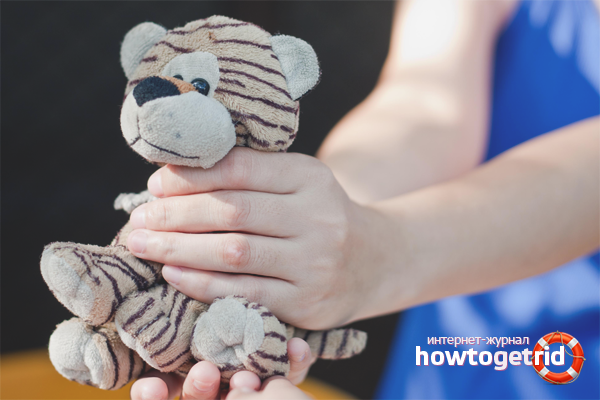
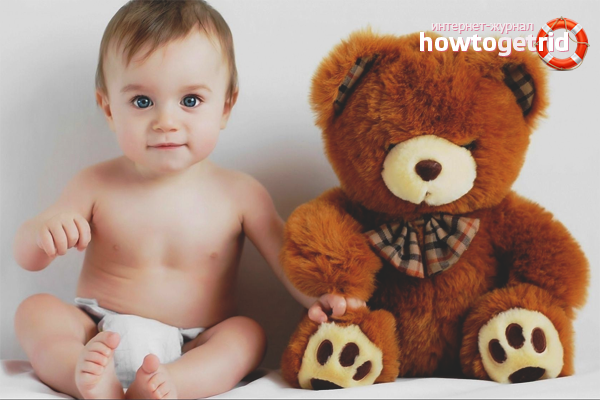
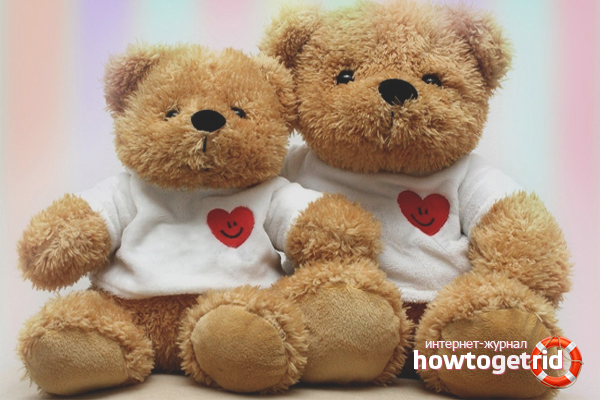
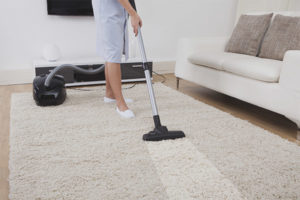
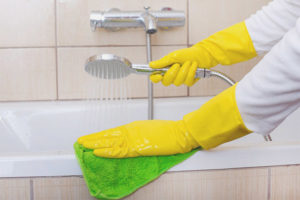
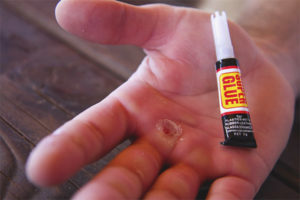

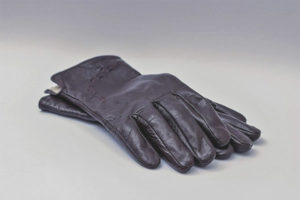

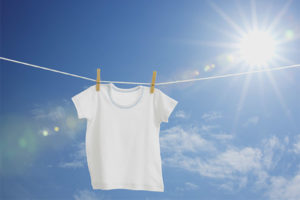

Submit